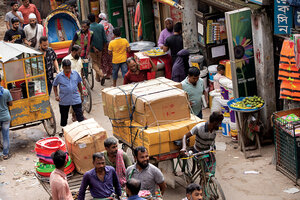Old Dhaka is noisy and crowded. It’s just the jolt of life a traveler needs.

METROPOLIS ON THE MOVE: Pedestrians, rickshaws, cars, and trucks squeeze through the narrow streets of Old Dhaka, the historic district of Bangladesh’s capital.
Melanie Stetson Freeman/Staff
Dhaka, Bangladesh
It’s impossible to comprehend just how crowded Bangladesh’s capital is until you are in the thick of it. Especially in the middle of Old Dhaka, as the capital’s bustling historic district is known, where you might disembark from a rickshaw at your own risk, threatened on the frenetic and narrow streets by weaving motorbikes, delivery trucks, and other rickshaws laden with passengers.
A visit to Old Dhaka – to see the old-fashioned ferries that ply the Buriganga River; to visit the Ahsan Manzil, or Pink Palace; or to taste the mixed-rice dish biryani – is not for the faint of heart, or of ears. From the moment you get here (and don’t be surprised if it takes 90 minutes to arrive from your hotel only 12 kilometers, or 7.5 miles, away), you are greeted by an intensity of noise you aren’t likely to experience anywhere else in the world.
At one point, photographer Melanie Stetson Freeman and I ascended a store owner’s staircase to look out from his balcony onto the landscape below, giving us an opportunity to experience the scene without being part of it. In that moment, I recalled a conversation I had had earlier that day with our Bangladeshi reporting partner. “Where do you go for alone time?” I had asked.
Why We Wrote This
Instead of trying to understand Old Dhaka through a Westerner’s lens, it helps to see what Bangladeshis see: community, life, togetherness.
He looked at me funny. He explained that when traveling abroad – to places such as Berlin or Boston – many Bangladeshis miss the energy generated by so much humanity. They don’t see solace in those less crowded spaces, but emptiness.
Instead of trying to understand Old Dhaka through my own lens, I tried hard to see what he saw: community, life, togetherness.
For more visual storytelling that captures communities, traditions, and cultures around the globe, visit The World in Pictures.


